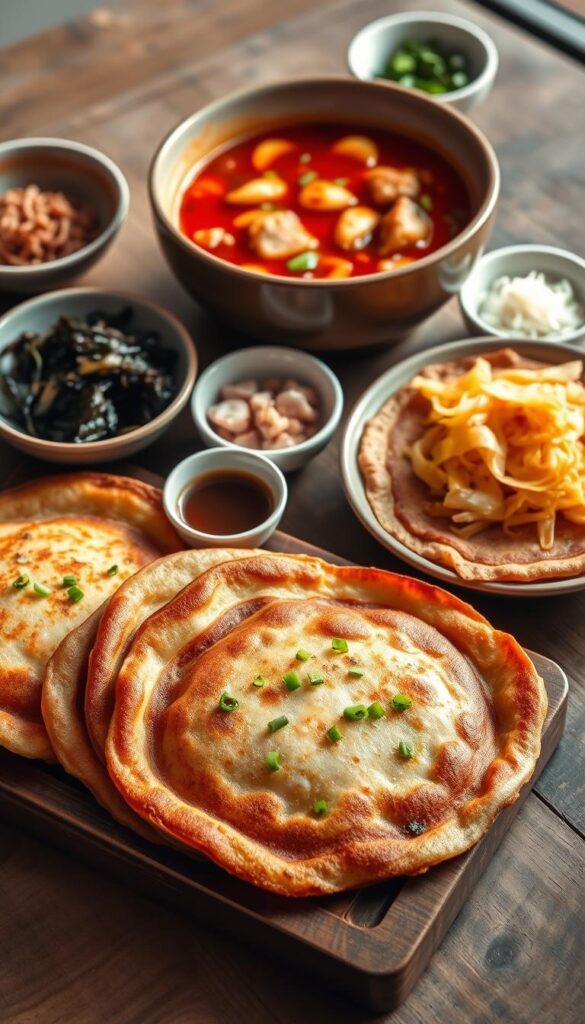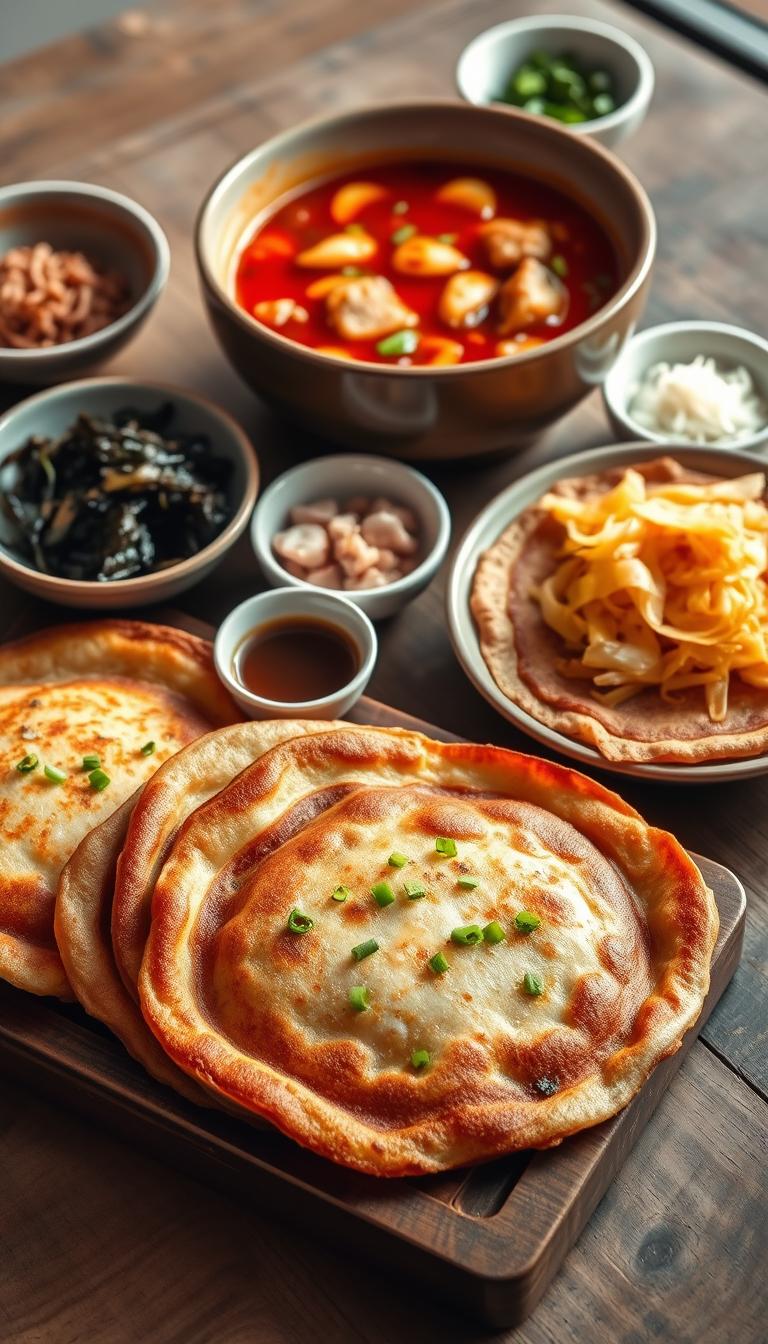Korean Savory Pancakes, known as Pajeon, are a delightful culinary experience that brings together a symphony of textures and flavors. These pancakes are a staple in Korean cuisine, celebrated for their crispy edges and tender, flavorful insides, often studded with vibrant green onions. Whether you’re enjoying them as an appetizer, side dish, or a light meal, Pajeon is undeniably a crowd-pleaser that offers a taste of Korea’s rich culinary tradition.
Origin and Cultural Significance
Pajeon holds a special place in Korean culture, often associated with rainy days and cozy family gatherings. Legend has it that the sound of raindrops resembles the sizzling of these pancakes in a hot pan, making them a comforting choice during a storm. Historically, Pajeon was consumed as a snack or quick meal, originating from the agricultural regions where ingredients were readily available and could be quickly assembled. Today, Pajeon is enjoyed by people all over the world who appreciate its simplicity and the rich cultural tapestry it represents.
Unique Ingredients and Flavors
The beauty of Pajeon lies in its straightforward yet versatile ingredients. The star of the show is the green onion, or “pa” in Korean, which provides a sharp, aromatic kick that pairs beautifully with the savory batter. The batter itself is typically made from a blend of wheat flour and rice flour, giving it a unique texture that is both chewy and crispy. The addition of seafood such as squid or shrimp can elevate the dish, adding layers of flavor that tantalize the palate. A splash of soy sauce and a hint of sesame oil in the dipping sauce bring everything together, enhancing the umami flavors and making each bite a delightful experience.
Cooking Techniques and Tips
Mastering Pajeon is all about technique. Achieving that perfect balance between crispy and tender requires a keen eye and a steady hand. The batter should be just the right consistency—not too thick to ensure crispiness, yet not too thin so it holds the ingredients together. Preheating the pan and using a generous amount of oil is crucial to achieving the iconic crispy edges. And don’t rush the process; let the pancake cook undisturbed until it’s golden brown before flipping. This patience pays off, delivering a Pajeon that is both visually appealing and bursting with flavor.

Korean Savory Pancakes (Pajeon)
Description
Crispy on the outside and tender on the inside, these Korean pancakes are a delicious treat filled with scallions and a touch of seafood or vegetables.
Ingredients
For the Pancake Batter
For the Fillings
For the Dipping Sauce
Instructions
Preparing the Batter
-
Mix the Dry Ingredients
In a large mixing bowl, combine 1 cup of all-purpose flour and 1/2 cup of rice flour. This blend gives the pancakes a crispy texture.You can substitute rice flour with cornstarch if desired. The key is to maintain that delightful crisp! -
Create the Wet Mixture
In a separate bowl, whisk together 1 cup of icy cold water and one egg until well-blended. The cold water helps to keep the batter light.For a vegan version, you can skip the egg and add a bit more water, adjusting for consistency. -
Combine Wet and Dry Mixtures
Pour the wet mixture into the dry ingredients, stirring gently until just combined. Be careful not to overmix to keep the batter airy.It's okay if a few lumps remain—overmixing will make the pancakes dense.
Preparing the Vegetables
-
Slice the Green Onions
Take a bunch of green onions and slice them into 2-inch pieces. These will be the stars of your pajeon.You can also add other vegetables like julienned carrots or zucchini for extra color and flavor.
Cooking the Pancakes
-
Heat the Pan
In a large non-stick skillet, heat 2 tablespoons of vegetable oil over medium-high heat until shimmering.Ensure the pan is hot before adding the batter to achieve that perfect crispy crust. -
Cook the Pajeon
Pour a ladleful of batter into the pan, spreading it thinly to cover the surface. Arrange a generous amount of green onions on top, pressing them gently into the batter.For extra flavor, you can sprinkle some sesame seeds on top before flipping. -
Flip and Finish Cooking
After about 3-4 minutes, when the edges are golden brown and crispy, carefully flip the pancake. Cook for another 2-3 minutes until both sides are golden.Use a wide spatula to flip the pancake to avoid breaking it. Patience is key!
Serving Suggestions
-
Prepare the Dipping Sauce
Mix 2 tablespoons of soy sauce, 1 tablespoon of rice vinegar, a dash of sesame oil, and a pinch of sugar. Add a sprinkle of chopped green onions and sesame seeds.Feel free to add a bit of chili flakes for some heat if you like a spicy kick. -
Serve and Enjoy
Cut the pancakes into wedges and serve hot with the dipping sauce on the side.Pajeon is perfect as an appetizer or a light meal, especially when paired with a refreshing cucumber salad.
Note
For a crispier texture, ensure the batter is chilled before cooking. The combination of rice flour and all-purpose flour is key for achieving the perfect balance of chewiness and crispness. Adjust the thickness of the batter by gradually adding water until it reaches a pancake batter consistency—thicker than crepe batter but not as thick as American pancake batter. Use a non-stick skillet or well-seasoned cast iron pan with a thin layer of oil for even cooking and a golden crust. Allow the pancakes to cook undisturbed until the edges are crispy before flipping; this helps them hold together. Flip confidently in one fluid motion to avoid breaking. After cooking, drain the pancakes on a wire rack or paper towels to remove excess oil, maintaining their crispness. Customize by adding kimchi, seafood, or various vegetables like zucchini and mushrooms for more depth of flavor. For dipping sauce, combine soy sauce, rice vinegar, sesame oil, and a pinch of sugar for a balanced, tangy complement. Serve immediately for optimal texture, as they tend to lose crispness when cooled. Store any leftovers in an airtight container in the fridge and reheat in a skillet to revive the crispiness.

